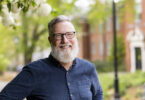Every spring, thousands of horseshoe crabs swim to the shores of Georgia’s barrier islands to lay their eggs before slipping back into the sea. This year, 38 teachers from seven states watched.
In the mid-1990s, horseshoe crab population management had the potential to become a conservation issue because of multiple demands for the crabs and their eggs. Adult crabs, which take between nine and 11 years to reach sexual maturity, are harvested by commercial fisheries to be used for fertilizer and bait and by the biomedical industry, which uses their blood to screen vaccines and other medicines. Female horseshoe crabs, which can lay up to 4,000 eggs in a single cluster, and up to 25 clusters a year, also provide vital nutrients for shorebirds that eat those eggs during their annual migration from South America to Canada.
From May 4-6, UGA’s Marine Extension Service hosted the third annual Green Eggs and Sand Horseshoe Crab and Shorebird Education Workshop, co-sponsored by the Sapelo Island National Estuarine Research Reserve. Developed in Delaware in 2000 and held on Skidaway Island since 2005, the program is designed to educate middle and high school teachers about horseshoe crabs and migratory shorebirds. At the end of the weekend, the educators leave with lesson plans and tools to teach what they’ve learned to their students.
The workshop curriculum focuses on four areas: horseshoe crab biology and ecology, the shorebird connection, human connections and managing natural resources. The teachers, who traveled from as near as Savannah and from as far away as New Hampshire, worked closely with scientists, fishery managers and aquatic education specialists and had the chance to see first-hand shorebirds feasting on the crabs’ bright green eggs. They also learned ways to educate their students about horseshoe crab anatomy, spawning, ecology and life cycle, shorebird identification and feeding behavior, the history of horseshoe crab use and the value of them as a natural resource.
“This program is a unique opportunity for educators to be immersed in a field-based learning experience that brings together an eclectic mix of people, expertise and educational resources,” said Dodie Sanders, a UGA marine educator and outreach program coordinator. “When the teachers leave, they are armed not only with the experience itself, but with a nationally-recognized, standards-based curriculum package that they can take back to their classroom.”






